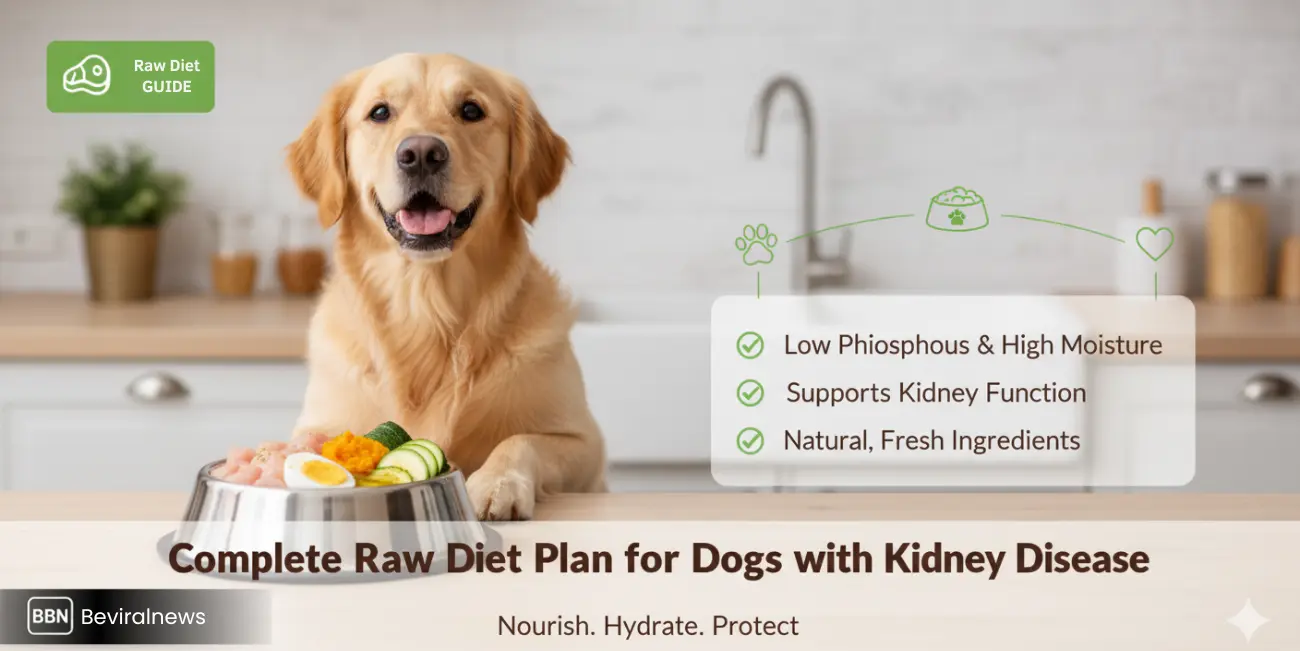Kidney disease in dogs is a heartbreaking condition that requires careful dietary management. If your furry friend has been diagnosed with kidney disease, you may be wondering how to support them nutritionally. One potential option is a raw diet plan for dogs with kidney disease, which can help reduce strain on the kidneys while providing essential nutrients.
But is a raw diet the right choice? How can you prepare one that’s safe and beneficial? Let’s dive deep into everything you need to know about crafting a kidney-friendly raw diet for your pup.
Understanding Kidney Disease in Dogs
The kidneys play a crucial role in filtering waste from the blood, balancing fluids, and regulating essential minerals. When they start to fail, toxins build up, leading to symptoms such as:
- Increased thirst and urination
- Weight loss
- Loss of appetite
- Lethargy
- Vomiting
A proper diet can make a huge difference in managing these symptoms and improving your dog’s quality of life.
Why Consider a Raw Diet for Dogs with Kidney Disease?
A raw diet, when properly formulated, can provide high-quality protein, healthy fats, and essential nutrients while minimizing harmful additives and excessive phosphorus. Traditional kibble diets often contain fillers and artificial ingredients that may burden weakened kidneys.
Benefits of a Raw Diet for Kidney Disease
✔ Low phosphorus content – Helps prevent further kidney damage
✔ Easier digestion – Reduces stress on the digestive system
✔ High moisture content – Supports hydration, which is crucial for kidney function
✔ Natural and fresh ingredients – Eliminates artificial preservatives and chemicals
However, it’s essential to ensure nutritional balance so your dog gets all necessary vitamins and minerals without worsening their condition.
Step-by-Step Guide to a Kidney-Friendly Raw Diet
1. Focus on High-Quality, Low-Phosphorus Proteins
Protein is essential, but for dogs with kidney disease, it must be high quality and in moderate amounts. Good protein sources include:
- Lean meats like chicken, turkey, and rabbit
- Egg whites (low in phosphorus but high in protein)
- Cottage cheese (in small amounts, as it’s lower in phosphorus than other cheeses)
🚫 Avoid organ meats like liver and kidney, as they are rich in phosphorus.
2. Increase Hydration with Moisture-Rich Foods
Since dogs with kidney disease struggle to stay hydrated, a raw diet naturally helps by providing moisture. Include:
- Fresh bone broth
- Water-rich veggies like cucumber, zucchini, and bell peppers
💡 Tip: Always provide fresh water and consider adding extra moisture to meals.
3. Limit Phosphorus Intake
Excess phosphorus accelerates kidney damage. Along with choosing low-phosphorus proteins, opt for foods that naturally help regulate phosphorus levels:
- Egg whites (great source of protein with low phosphorus)
- White rice (low phosphorus alternative to brown rice)
- Pumpkin (helps with digestion and is low in phosphorus)
4. Add Healthy Fats for Energy
Dogs with kidney disease may struggle to maintain weight, so healthy fats provide a great energy source:
- Fish oil (rich in Omega-3s, supports kidney function)
- Coconut oil (anti-inflammatory benefits)
- Flaxseed oil (good alternative for Omega-3s)
5. Supplement with Essential Nutrients
A balanced raw diet should include:
- Calcium (helps bind phosphorus—egg shells or bone meal can help)
- B vitamins (support overall health and energy levels)
- Probiotics (aid digestion and gut health)
🔍 Consult with a veterinarian before adding any supplements.
Sample Raw Diet Meal Plan
Here’s an example of a kidney-friendly raw meal:
🦃 Protein: 50% ground turkey (or chicken)
🥚 Egg Whites: 2 cooked egg whites (to reduce avidin)
🥒 Veggies: 20% zucchini and pumpkin (pureed for easy digestion)
🐟 Healthy Fats: 1 tsp fish oil
🐾 Calcium: Crushed eggshell (for phosphorus binding)
💦 Moisture: Bone broth (added to the mix)
Transitioning Your Dog to a Raw Diet
Switching your dog’s diet too quickly can cause digestive upset. Follow this gradual transition plan:
1️⃣ Week 1: Mix 75% of your dog’s current food with 25% raw food.
2️⃣ Week 2: Increase raw food to 50% while decreasing kibble.
3️⃣ Week 3: Feed 75% raw, 25% kibble.
4️⃣ Week 4: Fully transition to a raw diet.
💡 Watch for changes in stool consistency and energy levels. If issues arise, slow down the transition.
Common Mistakes to Avoid
🚫 Feeding too much protein – Excessive protein can stress the kidneys.
🚫 Ignoring phosphorus levels – High phosphorus can worsen kidney disease.
🚫 Lack of veterinary guidance – Always work with a professional to ensure proper nutrient balance.
Final Thoughts: Is a Raw Diet Right for Your Dog?
A raw diet for dogs with kidney disease can be highly beneficial when properly formulated. It helps reduce phosphorus intake, provides hydration and high-quality nutrients, and avoids harmful preservatives found in commercial dog food.
However, always consult your vet before making dietary changes. Each dog is different, and their needs may vary depending on the stage of kidney disease.
If you’re ready to give your pup the best nutrition possible, start with small adjustments and monitor their progress. A healthier, happier life is within reach! 🐶❤️
👉 Looking for high-quality raw dog food? Check out our recommended brands that prioritize kidney-friendly ingredients! Shop Now 🛒

